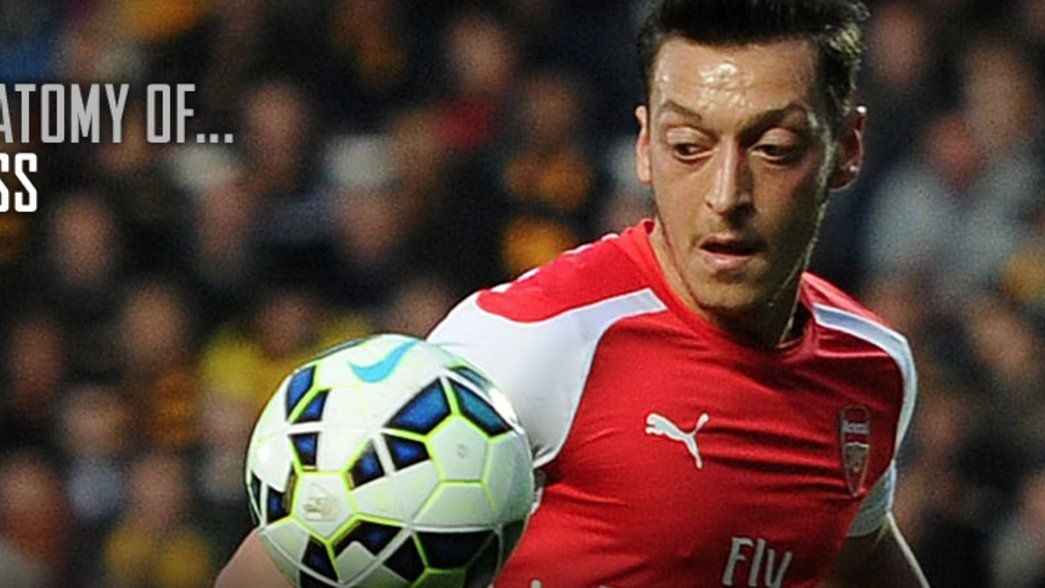It was probably the most memorable moment of what was a stellar Arsenal career. When Liam Brady received the ball midway inside the Manchester United half 43 minutes into the 1979 FA Cup final, he embarked on a typical slaloming run before picking out Frank Stapleton to head home the Gunners’ second goal in what would become one of the most dramatic finals Wembley has ever seen.
It was no coincidence that Liam’s lofted pass was perfect for Stapleton to score in that dramatic 3-2 win. In fact, that very combination - Brady to Stapleton - created plenty of goals during the six years the pair spent together in north London. So why was their understanding so strong?
“We had a good relationship that was built up over a number of years,” Liam recalls. “As I picked up the ball in midfield or around the box, he would make the runs that I could pick out. I knew what he was going to do.
“He would pretend to go to the near post and spin to the far post and vice versa. It was a relationship that we built up over the years.

Liam Brady
“We did that on the training pitches. Don Howe used to put on drills for us and we would work on running off the ball. When I had time on the ball to pick out a pass, Frank would move for me. We played together in the youth team, so it wasn’t just down to the coaching, but us knowing each other so well from the training pitch definitely helped too.”
Liam was one of the finest playmakers of his generation. He set up goal after goal for team-mates at Arsenal and was named in every PFA Team of the Year between 1978 and 1980. Upon leaving Highbury, Liam won successive Serie A titles with Juventus in the early 1980s, before going on to represent Sampdoria, Inter Milan, Ascoli and West Ham United, as well as Republic of Ireland, for whom he won 72 caps. That ‘Chippy’, as he is affectionately known, was able to regularly light up stadiums including Highbury, Stadio Comunale Vittorio Pozzo and Lansdowne Road stems from hours of practise honing his skills on the streets of Dublin, where he grew up.
“When I was a kid, I would hit a ball against a wall for hours,” he remembers. “I think that’s one of the best ways to improve. I’d hit all sorts of passes and try and hit the wall I was hitting it against, and then try to hit the next pass first time. It would increase the difficulty of what you were doing and help you to practise different passes too, because sometimes the ball would bounce up, or come back to me with a lot of pace on it.”
That hardworking attitude always stayed with Liam, who made 307 appearances for the club after coming through the youth ranks. While at Arsenal, it was the norm for him to stay behind after training to practise different types of passes, often with midfield colleague Graham Rix. But as Liam is keen to point out, becoming an adept distributor of the ball requires more than just technical ability.

Liam Brady scores against Tottenham Hotspur in 1978
“First of all, awareness is crucial,” he says. “You need to have the football brain and the intelligence to see what’s unfolding in front of you. In my role as academy manager, I always made it clear that the run would have to come before the pass.
“Then it’s all about the feel of the ball and how much pace you put on it. It’s complex, but you have to know your distances. If you’re hitting a 20-yard pass or a 40-yard pass, it’s all about the strength with which you kick the ball. It’s a bit like playing golf. Everybody has golf clubs in their bags that they use for different distances. The way you pass is the same - you won’t take a full swing of your leg if you only want to pass a short distance.
“There are different ways of passing - you can put spin on it, drill it with your instep, or sidefoot it. It’s a real art and depends on the situation you find yourself in. One of the most important aspects of the game is keeping possession of the ball. You have to be able to find the man you want, and disguise what you’re going to do, because you’re up against opponents who try to second guess where you’re going to pass.
“It’s pointless a forward making a run if the passer isn’t ready to play the ball. The run comes first and then the pass comes as quickly as possible after that. If you see a pass that comes first and then the run follows, invariably the ball will be lost. So there’s a huge significance on timing and understanding as well.”

Liam Brady
After retiring, Liam returned to Arsenal to head up the club’s academy. During a richly-successful 18-year spell in charge of youth development between 1996 and 2014, he implemented a pass-orientated style of play across all age groups, with a significant focus on manoeuvring the ball.
“It’s something that is very prevalent with the first team,” Liam explains. “I would say we’re the best passing team in England and have been for many years under Arsène Wenger. If you want to produce good players, you have to produce good passing players. You see guys like Jack Wilshere and Kieran Gibbs, lads who have come up through the academy and are comfortable on the ball and have a good range of passing.
“It was harder when I was playing, because you would have to contend with the ball hopping about on a piece of mud of uneven turf. It’s not like that now and it must be a dream to play on the pitches that are used in the modern game. There were still some great passers from my generation. Glenn Hoddle was one of the best in England, and Ray Wilkins was good too, though he had the reputation for not risking a lot of passes. Osvaldo Ardiles was very good at short passes and then there was Tony Currie.
"However, one of the best passers of the ball in my memory was Bobby Charlton. I never got to play against him but he was a brilliant passer with both feet.
“Of the current squad, Santi Cazorla is phenomenal on his left or his right,” Liam concludes. “The guys that are the best passers in the Arsenal team now, the likes of him, Mesut Ozil and Wilshere, have all got that ability to disguise what they’re going to do on the ball, and the awareness to move play on quickly, which really suits Arsenal’s style.”
Top Five Passes this season

Danny Welbeck celebrates against Aston Villa
Danny Welbeck
Aston Villa 0, Arsenal 3
Villa Park
September 20, 2015
Premier League
A slide-rule pass to release Mesut Ozil and break the deadlock. Alex Oxlade-Chamberlain cushioned a volleyed pass to Danny Welbeck near the halfway line and he took a touch on his right foot before sliding a low pass forward, taking out three Villa defenders in the process. Ozil was now bearing down on goal, having beaten the offside trap and he expertly tucked home to complete a flowing move.

Mikel Arteta
Arsenal 1, Manchester United 2
Emirates Stadium
November 22, 2015
Premier League
Olivier Giroud's late goal was nothing more than a consolation, but it will still go down as one of Arsenal's best this season. There seemed to be little on when Mikel Arteta picked up possession just inside the Arsenal half, as the game was deep into injury time. But the skipper looked up as he crossed the halfway line, and floated a ball over the top of the United backline into Giroud outside the area. The Frenchman still had a lot to do, but he didn't break stride before crashing his first-time shot home.

Tomas Rosicky
Tomas Rosicky
Brighton & Hove Albion 2, Arsenal 3
Amex Stadium
January 25, 2015
FA Cup
Tomas scored the goal, but it was his no-look pass in the build up which made the move memorable. The Czech wriggled through on the edge of the area and fed Olivier Giroud inside the area, deceiving the home defence with a subtle pass while looking in the opposite direction. Giroud returned the ball with a lofted cutback and Rosicky steadied himself before hitting a first-time right-footed volley which beat the keeper low down.

Mesut Ozil
Arsenal 5, Aston Villa 0
Emirates Stadium
February 1, 2015
Premier League
The flick which set up Olivier Giroud's opener. There were just seven minutes on the clock when Per Mertesacker cleared his lines with an industrial punt forward from outside the area. The ball arrived waist height at Ozil, just inside the Arsenal half in the centre circle. With a first time flick off the outside of his left boot, he diverted the ball with inch perfect precision and pace into the feet of the onrushing Giroud. The striker was now beyond the Villa defence and he finished past Brad Guzan to make it 1-0.

Alex Oxlade-Chamberlain
Manchester United 1, Arsenal 2
Old Trafford
March 9, 2015
FA Cup
The weaving run on the edge of the area really opened up this chance up, but the timing of Alex Oxlade-Chamberlain's final pass presented Nacho Monreal with the opportunity to give Arsenal the lead in the FA Cup quarter-final. Mesut Ozil found Oxlade-Chamberlain outside the area and he dribbled his way past three United defenders before stabbing a pass to Monreal inside the area. That pass took two more opponents out of the game and Monreal finished inside the post.
Arsène Wenger on…

Alexis Sanchez
Why he loves the passing game…
Passing is the essence of our sport. Passing is experiencing me giving away the ball to somebody else. I love that because it's the basic act of generosity. Passing is being generous. Then you have being generous in different ways, different qualities of the pass. There's the timing of the pass, when you understand that if I give you the ball early, you have more time to give it away to somebody else. If I give you the ball a fraction of a second late, your opponent will have time to close you down and put you in trouble. Then, if I'm very intelligent, I can as well give you a pass that gives you the best possible opportunity to see a solution yourself. So I can give you a pass that makes the next solution available. Then I'm already in the second degree of passing. That means I make your life easier, I took part of your next job. So that is the super generous passer. There's the technique too. That means that I can see if I give you the ball on your right foot, it's easier for you to give the ball to the next player. Some people would give you the ball on your left foot and put you in trouble, but they think they have done a good pass.
What makes a good pass…
A quality pass is something that makes the circulation fluid. For that it demands technical ability of course, it demands intelligence and it demands a generous attitude. So I'm a big lover of the pass, but I'm also a big lover of the pass, but I'm also a big lover of the timing of the pass. If someone delays a pass, even if they make a good pass, they are giving the next guy in possession less time. All the aspects have to be right: the moment of the decision and the quality of the pass.
How a player chooses the best options…
The problem that I have sometimes when I am looking for a pass is that I have three or four green lights. If I have the ball, I want to have as many green lights around me as possible, then I have to choose the best green light. Then I have to make sure I give the green light I have chosen the best possible solution to find other green lights. That demands quick vision, quick decisions and quality in my execution. When I sit on the bench I sometimes realise how difficult it is in the modern game because I see a player receive the ball, and he might have two or three green lights. If he controls the ball, two lights have already gone out. Then he has to find new ones, and that's the difficulty of the modern game. The speed that the options available to the player go away because everybody is moving so quickly. They cut his possibilities off, so he has to create new solutions for himself, and also make sure there's a continuity.
The best passers he's seen…
It's so difficult to single people out, but in history people will talk about Bergkamp and Henry for example. I don't want to eliminate people but what I will say is that today our game is based on this. I encourage everybody to give the perfect ball always because I'm a great admirer of the pass. I think it's basically what makes our game great. A characteristic of Arsenal as well is first of all the pass, the quality of the pass, and we put a lot of effort into that and the way we build up our game.
Steve Morrow on passing

Steve Morrow
Passing is obviously a big part of our game at Arsenal, in terms of the quality of passing and the quantity too. Therefore it's a big part of our training and it's a big part of our development all the way through to the youngest teams in our academy.
If you try to break it down you could group it into two areas - one is passing to keep possession, and the other is passing to create opportunities - the more incisive passing in the final third. That calls for more creativity.
"There are players like Mesut Ozil too who has the creativity in the final third and makes the technique look very, very simple"
Steve Morrow
Passing stats are a big part of our analysis when we analyse our own players, but also when we are recruiting and identifying players to bring in. We look at the quality players who can complete high-risk passes in the final third and we take note of the success rates.
We coach basic technique in passing from an early age, we start practicing side-foot passing from the youngest age groups, concentrating on technique and accuracy, then we develop it from there. We also like our players to be able to use both feet when passing, and all parts of the feet.
One great pass at the right time can take out half a team, so we encourage them to take chances too and to improve their decision-making.
When you are looking at great passers in the game today you need to look no further than the Arsenal first team. It's packed with great passers. And when you talk about two-footed players, I can't think of a player I've seen before like Santi Cazorla who is able to manipulate the ball so well with both feet.
There are players like Mesut Ozil too who has the creativity in the final third and makes the technique look very, very simple, but we have these players throughout the team. Mikel Arteta and Jack Wilshere are great passers too and going back to when I was a player, Paul Davis was someone I always admired for his passing range.

Mesut Ozil
Copyright 2025 The Arsenal Football Club Limited. Permission to use quotations from this article is granted subject to appropriate credit being given to www.arsenal.com as the source.




